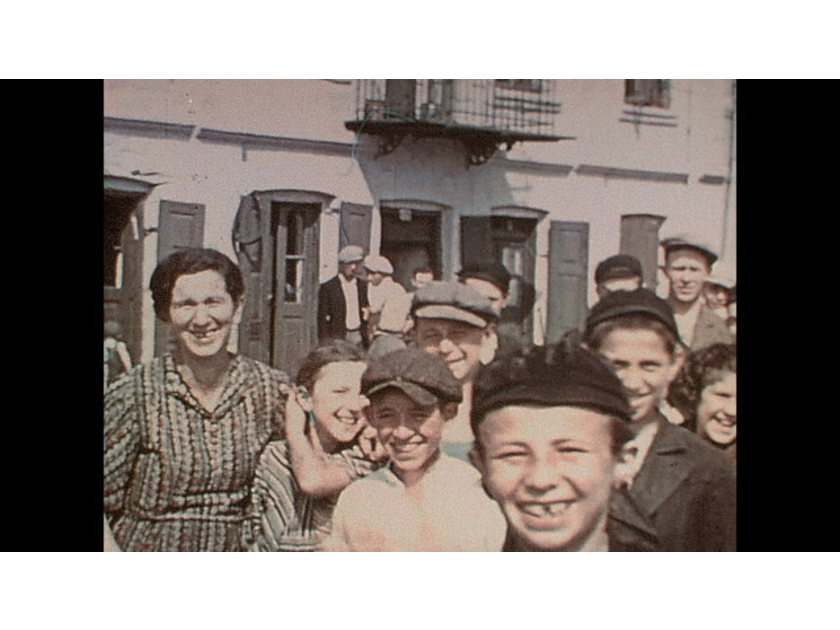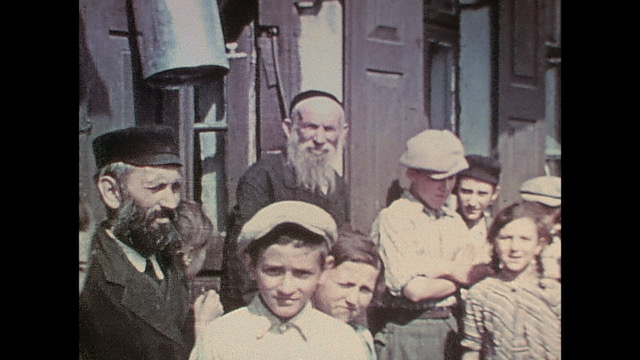
United States Holocaust Memorial Museum
In 2014 I published Three Minutes in Poland: Discovering a Lost World in a 1938 Family Film, a book about a home movie made by my grandfather, David Kurtz. During a six-week summer vacation with my grandmother in 1938, David revisited his birthplace — Nasielsk, Poland, a small town located thirty-five miles northwest of Warsaw. At the time — one year before the outbreak of World War II — Nasielsk was home to a Jewish community of about 3,000 people, roughly half the town’s population; fewer than one hundred of Nasielsk’s Jews would survive the Shoah. My grandfather’s three minutes of film are the only known moving images of this community prior to its destruction.
In one sense, the images are unremarkable. An unruly throng of children jostles for a position in front of the camera lens. Town residents exit the synagogue in a ragged procession. A young bully shoves the girl standing next to him. A proud hostess shoos curious onlookers away from her doorstep, clearing the way for her American guests to depart. But seen through the lens of history, these ordinary scenes become devastating. Watching the film today, we know what the people in the frame do not: how soon their lives and their way of life will end in violence.
I discovered my grandfather’s film in a closet at my parents’ home in 2009. It sat in an aluminum can for seventy years, slowly deteriorating until it was barely recoverable. The moment I saw this footage, I felt a profound responsibility toward the hundreds of people whose faces are so hauntingly visible. As much as I wanted to, I could not warn them of their impending fate; I could not save them. Yet through the fluke of the film’s survival, I was in a unique position to preserve their memory. I wanted to know what — and especially who—I was seeing. And I wanted others to see these faces, so that the film would stand as a memorial — not only to this lost community and to the thousands of others like it — but to these particular people.
When I discovered the film, however, I knew nothing about it. I never met my grandfather, who died before I was born, and my grandmother, although she lived well into her nineties, never spoke of their 1938 trip to Europe. I didn’t know why they went to Poland or what they did during their visit. I didn’t know what small Polish town appeared in the film or the identities of any of the people.
My grandfather’s film is thus silent in more ways than one. There is no audio, and so we do not hear the conversations or the commotion surrounding him as he panned his camera across the crowded market square. The film is also silent in a larger sense: It does not tell us what it is. The images are innocuous. Their poignance and power are evident only when we know the historical fact that these people would soon be victims of genocide. But just because we see these people does not mean we know them. And just because we know what happened to them does not mean we know anything about their lives.
I hoped to honor the life of this community, recognizing these people as individuals rather than as stereotypes, as men and women with complex lives.
Consequently, for five years I researched and traveled seeking to answer the deceptively simple question, “What do we see in this film?” Eventually, through a series of seemingly miraculous coincidences, I encountered seven survivors of Nasielsk’s Jewish community, including an eighty-six-year-old man and a ninety-four-year-old woman, both of whom appear in my grandfather’s home movie as young people. Recording their recollections and painstakingly piecing together the few surviving photographs, letters, and fragments of memory scattered around the world, I was able to document the history of Nasielsk’s Jewish community with more detail than I had dreamed possible. Ultimately, the survivors identified perhaps two dozen of the hundreds of people who appear in my grandfather’s home movie, as well as many more who do not appear in the film. Together, we preserved not only names, but stories, jokes and anecdotes, songs, arguments, and hints of scandal.
My grandfather’s home movie is now the subject of a documentary film, Three Minutes — A Lengthening, directed by historian Bianca Stigter, co-produced by Academy Award-winner Steve McQueen, and narrated by Helena Bonham Carter. Like my book, Three Minutes — A Lengthening asks one question over and over: “What do we see?” The director uses the camera to investigate each frame, isolating facial expressions and the patterns on women’s dresses, noting the mezuzot on door frames in the background, deciphering the name on a grocery store sign. In this way, three minutes in the life of the town are stretched into almost seventy, and the richness and complexity of what my grandfather captured is given time to unfold. Drawing on the information gathered in my book, as faces appear on the screen, we hear the names of some of the people we see, we learn a little about their personalities and histories. The documentary premiered at the Venice Film Festival in September 2021 and was an official selection at the 2022 Sundance Film Festival. It will be released in theaters this fall. Thanks to Bianca Stigter’s beautiful and sensitive direction, my grandfather’s home movie will now reach audiences around the world.
It still strikes me with wonder: Three minutes of amateur vacation footage! What would my grandfather think? Entirely unintentionally, he created a memorial to a lost community. He filmed only brief snippets of his visit, just a tiny sliver of the town’s everyday life. I’m certain he had little awareness of most of what he filmed, no inkling of its significance. He was on vacation. His camera was a novelty. He filmed casually, like a tourist.
Similarly, we can view these scenes casually. Without knowing anything particular about what we see, it would be easy to believe we understand it. So often with footage of prewar Jewish life in Poland, in the absence of knowledge, we make an empathetic leap over the lost details, assuming that we know these people because they seem so human, because they seem just like us. But there is a world of difference between identifying with the victims of the Holocaust and identifying them.

United States Holocaust Memorial Museum
Especially today, as the survivor generation passes away, the nature of any Holocaust memorial depends on the quality of our memory. Even among those who wish to remember, it is all too easy to content ourselves with generalities. Watching these three minutes, it is tempting to see only characteristic types — prewar shtetl Jews; future victims unaware of their imminent fate; representatives of “a world” on the brink of destruction. But every film and every photograph always captures more than generalities.
From the moment I first saw my grandfather’s film, I hoped to honor the life of this community specifically, recognizing these people as individuals rather than as stereotypes, as men and women with complex lives, with families, relationships, professions, secrets. Only by seeing specifically, with knowledge, do we recognize what my grandfather’s film preserves. And only in this way, I felt, can we begin to grasp the magnitude of what was lost.
In its passage from film to book and now back to film, my grandfather’s home movie has become a distinct kind of memorial. Yes, it shows us prewar Jewish life in Poland and anonymous victims of the Shoah. But if we know what we’re watching, we also see Chaim Nusen Cwajghaft standing skeptically aloof; Czarna Myrla laughing with her sister, Miriam; Avrum Kubel talking with his friend, Simcha Rotstein. We glimpse a few, achingly brief moments of Faiga Milchberg and Moszek Tuchendler just living their lives.
See David Kurtz’s original footage at the U.S. Holocaust Memorial Museum.
Watch the trailer for Three Minutes — A Lengthening.
Glenn Kurtz is the author of Three Minutes in Poland: Discovering a Lost World in a 1938 Family Film (Farrar, Straus and Giroux, 2014). The documentary film, “Three Minutes — A Lengthening,” directed by Bianca Stigter, will be released in theaters in fall 2022. More information is at www.glennkurtz.com.